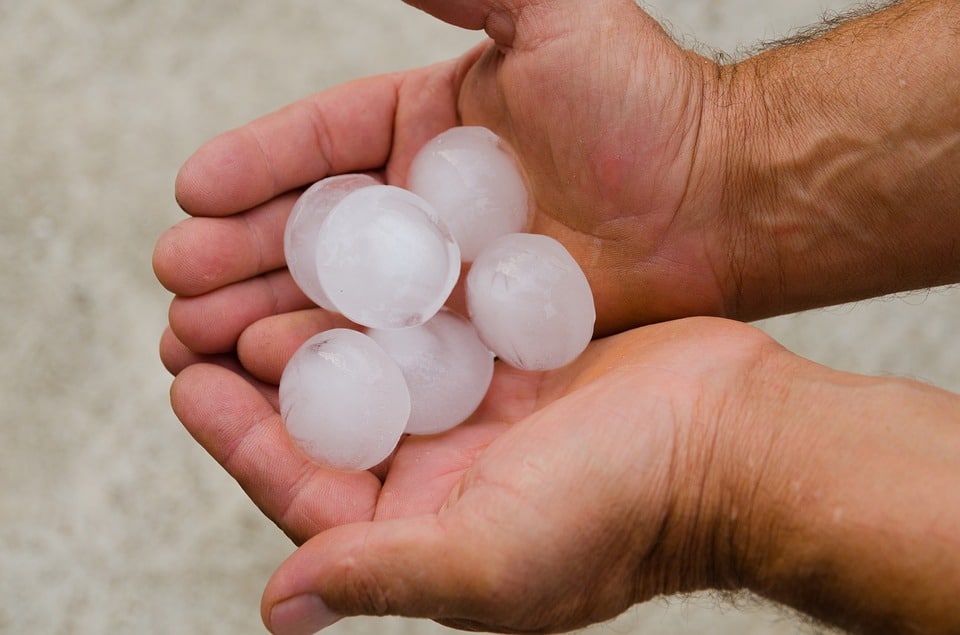Hailstorms are one of those natural occurrences that can catch you completely off-guard. What was originally forecast to be a simple thunderstorm can transform into a dangerous hailstorm at the drop of a hat. This might leave you feeling helpless as you huddle in your room, listening to the clattering hail wreak havoc on your home.
Hail ranges from the size of a pea to larger than a softball, and when it’s falling at speeds between 20 and 100 mph, it can do some substantial damage to the surface and structure of your home.
Parts of Your House that are Susceptible to Hail Damage
Hail can damage just about any part of your home, but some places are more likely than others. After a hailstorm, you should take a full inventory of the outside of your home, but pay careful attention to these specific areas.
Roof
It’s pretty obvious that your roof is going to take a beating in a hailstorm, so it’s crucial that you spend sufficient time evaluating the damage. Look for dented spots on your roof and for places where the shingles were broken or cracked. Broken shingles can lead to your roof leaking down the line, so it’s vital that you get them repaired immediately. Similarly, dented shingles can be indicative of damage under your shingles. If exposed to water later on, that damage can lead to rotting beneath your shingles.
You should also ensure that there are not any loose granules or pits in your shingles, so if you see a lot of granules collecting in your gutters, you could have more extensive damage than you thought. The granules are an important aspect of weather protection, so if a lot are missing, you could be well on your way to a leaky roof.
If you are comfortable, get up on your roof and look for signs of damage yourself. You’re going to need that information when you contact your insurance company. If you’re not comfortable with heights or your roofline is too steep, contact a professional roofer to come and evaluate the damage.
Gutters
Your gutters might not seem like as big of a problem as your roof, but when they’re damaged, you are just asking for trouble. Cracked and broken gutters and downspouts can divert water directly into your house via your roof, siding, and foundation. If you notice problems with your gutters, make it a priority to correct them as soon as possible.
Siding
Depending on what kind of siding you have, your house could be at high risk for damage during a hailstorm. Vinyl siding is durable and economical, but it has a hard time holding its own against hailstorms. The speed, size, and angle at which hail hits your house are all determining factors in how much damage you incur. To get the best visibility, you should inspect your siding for damage either in the morning or right before dusk.
The Windows
Windows, being made of glass, are highly susceptible to hail damage, but it may not be easy to see the problems right away. As you inspect your windows, look for small cracks and dents, and don’t be afraid to run your hand along your window to feel for damage. Fluctuating temperatures can make a tiny chip turn into a massive crack in no time at all, so it’s best to get those problems corrected as soon as possible.
What Should You Do After a Hailstorm?
Before you call your insurance company, you need to do some prep work around your house. Start by gathering information. Locate your insurance policy, and write down the date and time of the hailstorm. Take pictures of everything that has incurred damage: roof, siding, AC units, trees, windows, and the hail itself. (You can hold up an everyday object next to a hailstone to give your pictures perspective.) Measure the damage with a tape measure or ruler (where appropriate) so you can accurately convey its scope.
Take precautions to repair anything that needs immediate attention (leaks, broken branches, etc.) This may require calling in disaster cleanup specialists if the damage is severe enough. Then, contact a professional contractor to have them make an assessment about additional repairs. You’ll need this contractor estimate when you contact your insurance company to make your claim, and most contractors will perform the inspection for free. The insurance company will then send out an insurance adjuster to double-check your house and claim before processing your request.
After a hailstorm, it’s normal to feel overwhelmed by all that you have to do, but just take a deep breath and tackle one step at a time. Be diligent in your record-keeping and repairs so that you don’t run into residual problems in the future.

